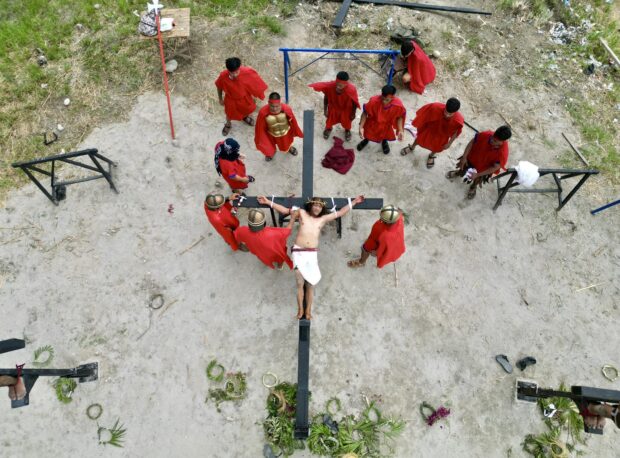
The passion and death of Jesus Christ are reenacted through a street drama in San Pedro Cutud in the City of San Fernando, Pampanga, with real-life crucifixion as the highlight in Calvary made out of Mt. Pinatubo’s volcanic ash. (Photo courtesy of ELGIE OLALIA MALANG)
CITY OF SAN FERNANDO, Pampanga, Philippines — Not wanting to see an end to Lenten traditions in his village, Ruben Enaje had himself crucified on the cross for the 35th time on Good Friday after playing the role of Christ in a 69-year-old street play that reenacted the Via Crucis (Way of the Cross) in this city.
In not vowing out as he had planned, this 63-year-old billboard-maker and house painter continues to be known as the Filipino who practices real-life crucifixion that long.
After the death of his fellow penitent, Bob Velez, who died of COVID-19 in 2022 at age 72, Enaje is now considered among the eldest in his league of less than 15 “papaku” (men and women who take to the cross for nailing) in this Pampanga capital, according to Mat Ryan de la Cruz, barangay captain of San Pedro Cutud.
The other old Kristo is Wilfredo Salvador, 67, of nearby Barangay San Juan. By his lonesome, he took to the cross for the 16th time at 10 a.m. also on Friday to continue his brood’s “panata,” Barangay Chair Claro Tolentino said.
READ: Look Through: Tradition of crucifixion: Pampanga’s ‘Kristo’ nears …
San Fernando tourism chief Ma. Lourdes Jade Pangilinan released the names of other penitents and the number of times they got nailed on the cross.
In Barangay Santa Lucia, they were Danilo Ramos, 53, 31st year; Joselito Capili, 59, 19th year; Fernando Mamangun, 53, 27th year (as main Kristo).
San Pedro Cutud: Orlando Gozon, 43, 6th year; Angelito to Ramos Menuillo, 48, 22nd year; Arnold Maniago, 45, 23rd year.
In Del Pilar, two men — Crisanto Ramos, 51, and Ubardo Yumang, 43 — began their crucifixion this year as sacrifices for the good health of their families.
Enaje took his turn at 1 p.m. — hanging, hunching his back, and praying while on the cross for 10 minutes. He prayed that every Filipino family would have food on the table and be spared from hunger (“Ela sa daranup”). He stayed for another 5 minutes below the cross to perform the La Pieta. The crowd of less than 20,000 hushed into silence, with some seen uttering prayers.
His “nailmen”— Romeo Diamse and Joel Celerio— did not hit a nerve when they hammered long steel nails on Enaje’s palms and feet.
“But the nailing is too painful. I can imagine Christ’s pain,” Enaje said when interviewed right after the rite.
Search for successor ‘Kristo’
The crucifixion in Cutud as a Good Friday penance or thanksgiving is traced to itinerant healer Artemio Anoza in 1962. Between 5,000 and 10,000 “mandarame” (flagellants who whipped their backs until bloody) accompanied the cross-bearers.
De la Cruz said the search for Enaje’s successor has been difficult. A prospect turned out to be a drunkard and philanderer. Several elders also disapproved of two replacements.
So Enaje persists with the crucifixion now more for the community than for his own individual goals.
“I’m doing this for our village so that the tradition would not be stopped,” he explained in an interview before the street play began at noon. Councilor Brenz Gonzales, chair of the Holy Week Committee, pleaded with him to keep the tradition going.
READ: Pampanga’s ‘Kristo’ prays for end of pandemic
Enaje’s first nine years of crucifixion began in 1986 as a form of thanksgiving for surviving a fall from a three-story building in 1985. The second set of nine years was for the healing of his wife. Another nine years was for his daughter’s healing. The 27 years were extended to seven more years. Social distancing and crowd control during the COVID-19 pandemic halted the rite for three years.
On Friday, Enaje carried a slightly lighter wood cross — 14 feet by 7 feet — that weighed 20 kilograms from the previous 37 kgs. He carried this for two kilometers, stopping at 14 stations to act out the street drama until the theater troupe reached a hill, their version of Calvary, on Purok Kuatro.
Allan Navarro threatened he would stop mounting the street play written by his grandfather Ricardo in 1955 if the new Kristo was not to his liking.